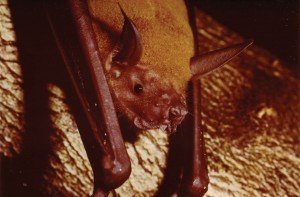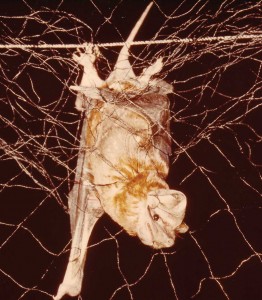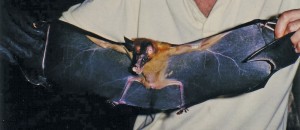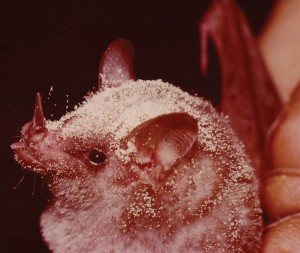What on Earth is a Chiropterologist

By Jack Ewing
“Would this be a good place to put the net?” I asked Otto. “You said you wanted an open path through the jungle.” I stepped into the shallow water of the narrow stream. “I can take one end of the net to the other side and hold it while you secure this end. Then you can join me.”
Otto hesitated. “Is there anything in this water that will hurt you,” he asked in heavily accented English.
“There are caimans and crocodiles” I replied, “but with all the noise we’ve been making they’re probably all gone by now.”
“No, no,” he exclaimed, “I mean little animals that live in the water.”
“Not that I know of. We walk through this water all the time and have never had any problems.”
Finally he agreed to string the mist net across the stream, but was extremely careful not to get water inside of his rubber boots. The natural corridor formed by the stream was a good choice. Over the next hour we captured five different species of bats in the net, including one bulldog bat.
One evening several days earlier I was returning to Hacienda Barú from San Isidro just before dark and noticed three men at the side of the gravel road near Tinamastes extending some very fine nets. I wonder what they’re doing, I thought. They look like foreigners.
Two days later a familiar looking rental 4WD drove up to my house at Hacienda Barú. Three men got out of the car, and I recognized them as the men at the side of the road with the nets. The older man introduced himself as Otto. The other two were Fabio and Gunther. They were chiropterologists he explained from Erlangen University in Germany.
“What on earth is a chiropterologist?” I asked.
Otto laughed. “Sorry for the big words. It means we study bats. We saw the sign out there at the road that says this is a private nature reserve, and we thought it might be a good place to capture and identify bats. Would that be possible?”
Not only was it possible, but we welcomed scientific study of all kinds. They ended up staying with us for a week. That first encounter in 1989 was the beginning of an enduring friendship that lasted for many years.
*****
That first night I went with Otto to the stream mentioned earlier, and Fabio and Gunther went to a place I showed them near the house. We used very fine nets called mist nets to capture the bats. The idea was to string the nets across natural corridors where bats normally fly. According to Otto, when flying on a route it knows well a bat will turn off its radar, or echolocation, and won’t detect the mist net. That first night, between the two teams, we captured seven different species. Over the next week we captured another eleven. All of the bats were identified and then released. Each new species for the list was photographed before releasing.

The largest bat Otto and I caught that first night was a fishing bat, sometimes called the bulldog bat because of its face. It had a wing span of 80 centimeters. I asked Otto if we were likely to catch any larger bats.
“Probably not,” he replied. “There is one carnivorous bat in Costa Rica, that has a wing span of about a meter, but it is very rare and has only been seen in one location in Guanacaste. I doubt if I’ll ever be fortunate enough to see one. It’s the largest true bat in the world. When I say ‘true bat’ I don’t count the flying foxes of Asia.” He went on to explain that all of the bat species found in North America and Europe eat insects, whereas in Costa Rica we have bats that feed on fruit, nectar, fish, frogs, blood, birds, and other bats. And, of course, we have insect eating bats.

On the second day we were sitting around after lunch and Otto showed me a cartoon in a biology magazine. It showed two scientific types meeting in the middle of a tropical swamp. One was wearing a swim suit but is otherwise bare from the waist down. Above the waterline he is completely covered including long sleeves, gloves and netting over his head. The lower body of the second is covered with chest-high waders but he is shirtless and hatless. “What are you studying,” he asks the first? “Malaria” comes the reply. “How about you?” “Bilharzia” says the one with the waders. (Bilharzia, sometimes called schistosomiasis is a horrible disease caused by a waterborne parasite carried by a snail. It is common in Africa and parts of South America.).
“That’s what you were talking about,” I laughed, “the other night when you asked if there were any little animals in the water that could hurt you. We’re lucky. We don’t have any bilharzia in Costa Rica.”
“Yeah. That’s what I was talking about,” he smiled.
Several nights later I sent the three biologists with Gregorio, the forest guard, to spend the night in our jungle camp deep in the rainforest. I thought it would be a great place to find bats. I wasn’t able to accompany them, but got a first-hand description of the experience when they returned.
Gregorio and Fabio went to a stream where they set up a net. Otto and Gunther stayed at the camp and set two nets. Before they got the second net fully extended Otto had to return to the first net to free three captured bats. He didn’t have time to identify them so he turned them loose in one of the tents thinking he would identify them later. Soon the bats were coming faster than he could free them from the net. Gunther had the same problem with his net. “Take your net down and come and help me,” called Otto, “I can’t handle all of these bats by myself.”
“I can’t get the net down,” hollered Gunther. “It’s too full of bats. I have the same problem as you.”
Otto quit taking time to put the bats in the tents and just untangled them from the nets and released them. It was the only way he could possibly empty the net and get it down. With only one net, he and Gunther could probably keep up with the bats. He almost had the net empty when he heard Gunther exclaim, “Oh my God, look at that.”

Otto hurriedly untied his net, let it drop to the ground and ran to help Gunther. “Good God,” Otto cried out. “Is that what I think it is?” The net was in tatters with at least five bats in a tangled mess. One bat, much larger than the others was in the middle of the glob eating one of the smaller ones. “It is. It really is a Vampyrum spectrum. I didn’t think I would ever see one. Hurry, let’s get him out of the net, and stay clear of those teeth.”
It took them 20 minutes to free the bats. Otto held the false vampire bat by the wings while Gunther photographed it. They decided to keep it in one of the tents overnight so they could examine it more closely in the morning, and get more photos.
“Sorry about your net,” said Otto. “It’s beyond repair. That monster tore it to shreds. You’ll have to get a new one.”
Gunther looked at him with a devilish grin. “We are going to have some explaining to do,” he replied. “That was Fabio’s net. He took mine by mistake, so I used his. He’s not going to be happy about this.”
“Well, maybe we can all go together and share the expense of a new one. After all this is quite an accomplishment for the whole team. We can publish a paper in one of the journals. Just think. This one bat made the cost of the whole trip to Costa Rica worth it. We’re not going to worry about losing a net.”

Otto and Gunther didn’t put any nets back up. Instead they went about identifying the bats they were holding in two of the tents. They left the tent with the false vampire bat closed so as not to risk losing it. The task would be much easier in the daylight.
Shortly after they finished Fabio and Gregorio returned. “How did it go?” asked Otto.
“Not too bad,” replied Fabio. “I got another new species for the list. How about you guys. You catch anything interesting?”
“Well,” said Otto, “this is one of those good news — bad news stories.” Fabio just looked puzzled, but didn’t speak. “We got four new species.”
“That’s great,” said Fabio, still dubious.
“Including a Vampyrum spectrum,” interjected Gunther.
Fabio stared in disbelief. “You’re putting me on, right? You didn’t really catch one?”
“Yes, we really did,” said Otto solemnly. “The bad news is that we caught it with your net.” He pointed his flashlight at the tattered mass of filaments on the ground by one of the tents.
Fabio broke into a broad grin. “This is unbelievable. Tell me all about it. I’m dying to hear.”
“We can do better than that,” smiled Otto. “We still have him. He’s in that tent over there.”
The three chiropterologists slept outside that night next to the tent with the world’s largest true bat. They said they didn’t sleep much. They rested and dozed listening to the sound of crunching bones as the false vampire bat devoured the four other bats in the tent.
Dr. Otto Helversen returned to Hacienda Baru many times over the years, as did several of his graduate students. To date they have identified 24 species of bats on what is now the Hacienda Baru National Wildlife Refuge. We call them “The Bat Guys”.

